On Tuesday, May 31 a series of marches and demonstrations with people numbering in the tens of thousands surrounded the Bolivian Parliament. On the third week of protests, demonstrations and roadblocks, as many as 100,000 workers, miners, peasants, the people of El Alto, and teachers, etc. vented their anger in central La Paz.
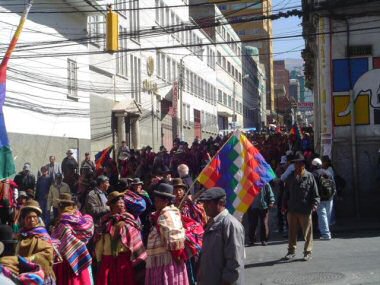 |
Picture: Indymedia Bolivia |
On Tuesday, May 31 a series of marches and demonstrations with people numbering in the tens of thousands surrounded the Bolivian Parliament. On the third week of protests, demonstrations and roadblocks, as many as 100,000 workers, miners, peasants, the people of El Alto, and teachers, etc. vented their anger in central La Paz. This was the day in which Parliament was supposed to resume its session. The masses of workers and peasants were not just there to put pressure on the parliamentarians but rather to ensure the fulfilment of their main demand: the nationalisation of Bolivia’s hydrocarbons.
The current revolutionary wave in Bolivia started four weeks ago when Parliament passed a Hydrocarbons Law increasing taxes and royalties. This law was too much for the multinationals but too little for the mass movement of workers and peasants, a movement which has struggled for nationalisation since October 2003. At that time they managed to overthrow the president, Sanchez de Lozada, but since the leaders of the movement had no clear alternative, Lozada was replaced by the vice president Mesa. Over the last year and a half, Mesa has been trying to manoeuvre between the interests of the oligarchy and the multinationals on one side and the formidable pressure from the mass movement on the other. The Hydrocarbons Law passed at the beginning of May was a recognition of his impotence and inability to reconcile these irreconcilable interests.
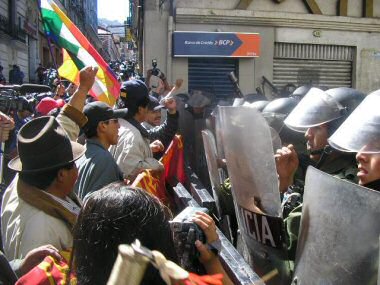 |
Picture: Indymedia Bolivia |
Even the leaders of the MAS, who have been the main point of support for the Mesa government, were forced by thousands of peasants to call for demonstrations and a march to the capital La Paz, 190 km away. On May 23, the peasant marchers arrived in La Paz and joined with the people of El Alto (who have been on an indefinite strike since then), the miners (who cancelled their union congress to join the protest), the La Paz urban and rural teachers (also on strike), the students from the El Alto Public University, and others. The leader of the MAS, Ramon Loayza had to admit that they had been “surpassed by the ranks” and gave Parliament four days to nationalise natural gas reserves and convene a Constituent Assembly. If this was not done he threatened that, “we will close down Parliament”.
On the other hand, the oligarchy threatened Mesa by saying that they would declare unilateral “autonomy” referendums in the Eastern regions of the country (Tarija, Santa Cruz, etc). They calculate that by doing this they will be able to reach their own separate deals with the multinationals for the exploitation of the gas reserves, which are mainly located in these regions.
Suspended in mid-air, opposed by the mass movement of workers and peasants, and by the main representatives of the ruling class, Mesa has been trying to cultivate the army in the last few days. In a speech to the Armed Forces he defended their right not to submit themselves to civilian tribunals in relation to the workers and peasants killed in the uprisings of February and October 2003. He also reminded everyone that the President has the right to use the army. But even within the army the situation is not clear for Mesa. Last week, two high ranking officers made a public statement calling for the resignation of Mesa, for the nationalisation of natural gas and the formation of a “people’s government”.
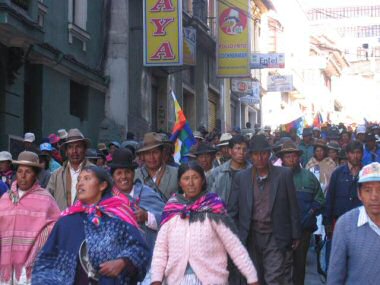 |
Picture: Indymedia Bolivia |
This stalemate between the classes, where the real power is in the streets, was graphically shown by the events on May 31. Parliament was supposed to start its session at midday. Very few MPs made it to the parliament building. MPs from Santa Cruz and the other Eastern regions refused to go to the session unless there was a prior agreement to recognise the “autonomy” referendums they are calling on August 12. The president of the Parliament, Vaca Diez, who is firmly aligned with the interests of the ruling class, and proposed by some as a replacement for the increasingly weak Mesa, was there only for a few minutes and then left, never to return.
Meanwhile, the leaders of the MAS were accusing the right-wing fraction of parliament of trying to organise a coup with Vaca Diez at its head. Evo Morales has always played the card of attaining power within the limits of discredited capitalist democracy, and is very keen to get Parliament to call a Constituent Assembly. This is in fact something that Mesa would be keen to do, as a way of demobilising a large section of the protestors. If Parliament were to pass a law calling a Constituent Assembly, Morales and the MAS leaders would immediately call on their supporters to go back home. Mesa would be comfortable with such an outcome, since it would demobilise the mass movement (or so he calculates) without him having to make any concessions on the main demand of the masses: the nationalisation of hydrocarbons.
Yesterday, Evo Morales went so far as to personally guarantee the safety of all members of parliament who were willing to take part in the session. In an attempt to square the circle, he tried to convince the oligarchy that the calling of a Constituent Assembly did not contradict their wishes for regional autonomy. In fact, for the mass of peasants who still follow the leaders of the MAS (and many of them are now further to the left of the leadership), if the Constituent Assembly means anything it means precisely the nationalisation of gas, and power in the hands of the people, the workers and peasants. For the Eastern oligarchs, “autonomy” means control over the gas resources so that they can sell them to the multinationals. How can these two conflicting interests be reconciled?
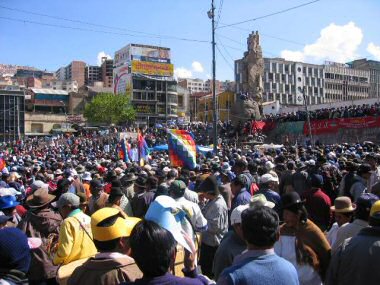 |
Picture:Indymedia Bolivia |
While the mass of workers and peasants are surrounding Parliament trying to close it down, Evo Morales and the leaders of the MAS are trying to shore up a discredited capitalist parliament, which not even the ruling class itself is very keen on anymore! Jaime Solares, leader of the Bolivian Workers Union, the COB, threatened that if parliament would not agree to nationalise gas, then they would “burn down parliament”. In the end the parliamentary session ended very late at night with only 66 out of its 157 members present. They were not able to reach agreement on anything.
Mesa is in fact suspended in mid-air. He accused COB leader Jaime Solares and one of the leaders of the Regional Workers Federation of El Alto, Roberto de la Cruz, of subversion and conspiring to overthrow the government, but was completely unable to have them arrested. At this particular moment it is unlikely that he can use the army against the masses, since, like in October 2003, this would further radicalise the movement and precipitate his own downfall (quite apart from the fact that it is not clear whether the army would follow such an order).
Real power is in fact in the hands of the masses of workers and peasants in the streets. Even the bourgeois parliament can only meet with the permission of the masses that surround it. The main problem now, like in October 2003, is not the strength of the mass movement (which is growing as the general strike and road blockades spread throughout the country) or its willingness to go all the way. The only factor that is missing is a leadership with a clear strategy of how to take power. In October 2003 the miners, workers and peasants surrounded Parliament and brought down the government. But their leaders (Solares and Quispe at that time) did not know what to do next, did not have a clear idea of what to replace the bourgeois Parliament with, and power slipped through their fingers back to Mesa. The moment was lost. Now the masses have gone through the experience of the Mesa government. Important sections of the movement (the workers, the trade unions, the people of El Alto) have already made it clear that they are fighting for a “workers’ and peasants’ government”. Even those, mainly the peasants led by the MAS who support the convening of a Constituent Assembly, see this as some form of government of the peasants and workers, where they will make the decisions.
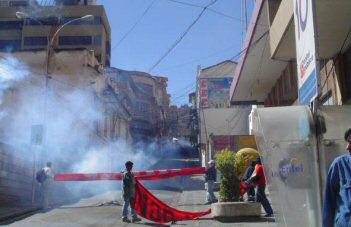 |
Picture: Indymedia Bolivia |
The crucial question is, what next for the workers’ movement? The main slogan should be for the calling of a Revolutionary People’s Assembly, composed of elected representatives of all trade unions, peasant organisations, neighbourhood organisations, etc, and that this Assembly take power into its own hands. This is the only strategy that can offer a way forward at this particular time.
Bolivian capitalism is in such a crisis that normal bourgeois democratic rule can no longer contain the revolutionary movement of the masses. Either the workers and peasants take power into their own hands or the ruling class will use one trick or another to take back power and smash the movement in the most brutal fashion.
